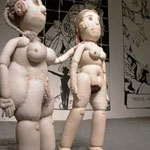Laredo is a bustling boomtown. Fortunately, in the last four years the art scene here has also boomed with the opening of several new contemporary art galleries: Sound Art Space, Gallery 201 and the Art Gallery of Texas A&M International University, as well as the evolution of the Laredo Center for the Arts into a contemporary venue for local, national and international artists.
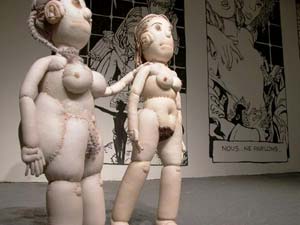
Sound Art Space — located in an old warehouse in central Laredo — was founded by several hardworking, enthusiastic local artists. They have developed an ambitious program of film festivals, alternative music performances and visual arts exhibitions.
Adam Parker Smith's humorous installation at Sound Art Space, It's Like That's All We Got to Look Forward to These Days, consists of 15 handmade, intentionally lumpy, obviously hand-stitched, toddler-sized stuffed dolls — standing alone or in clusters looking at artwork on the walls. The dolls gaze straight ahead at a series of portraits of themselves and a wall mural. During the reception Smith introduced the dolls with anecdotal stories about the friends that each doll represents.
There is a long history of dolls in literature, opera, ballet and the visual arts, including E.T.A. Hoffman's short story "The Sandman," published in 1815, the ballet Coppelia based on that story, the dismembered mannequin-dolls of Hans Bellmer, countless horror movies and the doll-like but live model-mannequins of contemporary artist Vanessa Beecroft.
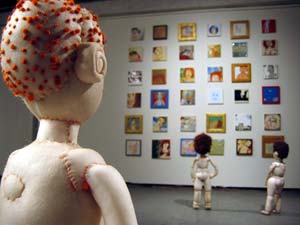
What intrigues readers and viewers about this subject is the sense of the uncanny — the unsettling possibility that the cozy and familiar we take for granted might flip to the unfamiliar or terrifying. In Sigmund Freud's 1919 essay "The Uncanny," he stated, " …the uncanny is that class of the frightening which leads back to what is known of the old and familiar." He added that what can be disturbing about dolls and other toys is our "intellectual uncertainty whether an object is alive or not" (translation by James Strachey).
Yet Smith's sturdy, passive stuffed dolls do not evoke this uncertainty. They are what they appear to be — leaving no doubt about their non-mortal status.
The approximately two-foot tall dolls are sewn from pantyhose stuffed with synthetic cotton. They have spiral, cinnamon bun-shaped ears and various colored yarns for hair — everywhere you would expect hair (using skilled embroidery stitches and knots, Smith has sewn approximations of pimples, curly pubic hair and underarm hair on the dolls). Their faces are graced with emotionally cool Mona Lisa smiles. The commercial doll's eyes even have "bags" under them.
Smith, originally a painter, began crafting the dolls after a friend told him of a dream in which Smith was painting sock-puppet portraits.
Smith first worked on paintings of puppets and dolls, then moved on to sew the actual dolls based on people he knows: his friends, family and ex-girlfriends. Despite their origins as specific people, the dolls do not have much individuality or distinctive facial expression. All of their mouths are a uniform, horizontal sausage shape with a stitched line to divide the upper and lower lips. The artist wants this passive neutrality. Yet he also hopes the viewers will engage with the dolls. Chitchat about the weather? Talk about the exhibit? Confide in the dolls about one's own love life? Unlike Duane Hanson's hyperrealistic sculptures that are frequently mistaken by viewers as humans, these dolls" stuffed-pantyhose origins fail to inspire that type of "realistic" interaction or response. They are simply cute, little stuffed dolls.
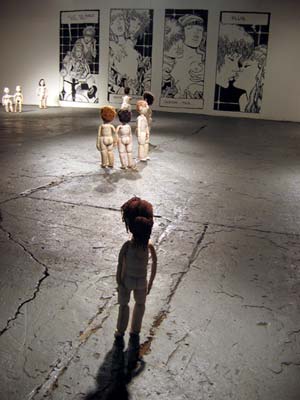
The portrait variations on the walls are arranged in two large grids on opposite sides of the gallery. They start at about the dolls" eye level and go up at least to human eye level. A black ink mural accompanying the portraits goes almost to the ceiling.
The portraits seem to be exploring different issues of the dolls" identify and their experiences in the context of their travel with the artist throughout the United States and Europe. The portraits are created by Smith, his friends and other artists he meets at each exhibition. According to the artist, the stuffed dolls are "a catalyst" for the multiple approaches the portraits take in mirroring the exhibition.
The artists he meets become an active, dynamic element of this growing, self-referential display. Smith gives a painter a canvas and either a photo of a doll or an actual doll from which to create a portrait, which is then added to the grid series. The canvas portraits show lively variations of techniques and media, from painting, collage and embroidery to snapshots of the dolls traveling. Most of the portraits are comical; some are graphic depictions of doll anatomies and the dolls having sex. The portraits vary from abstract, cartoony or naïve, to scary and outright creepy. One portrait uses the shape of the doll as a patterned background to frame a photo of a very cute shaggy dog.
The poster and website for the exhibit show dolls romping on a miniature motel bed in a fully furnished miniature motel room. I was anticipating a controversial, challenging experience — a gallery full of anatomically correct, naked dolls doing who knows what "while delving deeper into themes of love and loss," all right here in Laredo! But in fact there isn't enough going on between the dolls and the viewers to cause controversy or wariness. The installation is too sparse for that, though this sparseness does help to reinforce the exhibit's title.
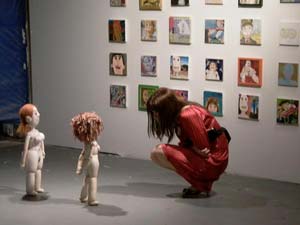
Because the majority of the artwork on the walls is at human eye level, and the dolls are not looking up, they are missing most of the action. Perhaps if the paintings were hung all along the floor, forcing everyone to be at the dolls" level, this extreme point of view might encourage at least a shared perspective.
I did ponder the black ink mural depicting a cartoon of one woman seducing another. What does this have to do with the little dolls? As it turns out — not much. This mural apparently is the "art" that the dolls are viewing while in the gallery. It is also the most titillating or provocative image in the exhibit. Eduardo Garcia, one of the gallery's founders, says the mural serves as the "functioning environment for the dolls experiencing an exhibition." The mural was painted by members of Sound Art Space, based on an image that the artist sent to them. Smith normally paints the wall images himself, but because of travel and time constraints, he was not able to do this here.
Also in previous installations the wall drawings directly reflected the activities of the stuffed dolls in the gallery, staged scenarios such as the dolls observing a beached whale or attending a funeral. The stagesets, plus the mural's actually mirroring their activities, would establish a more complex, lively and unified experience. At Sound there were no sordid motel rooms, no funerals, no beached whales to echo in a drawing. If there had been, it would have given the viewers — and the dolls — much more to look forward to.
Images courtesy Sound Art Space.
Alma Haertlein is a writer living in Laredo.


